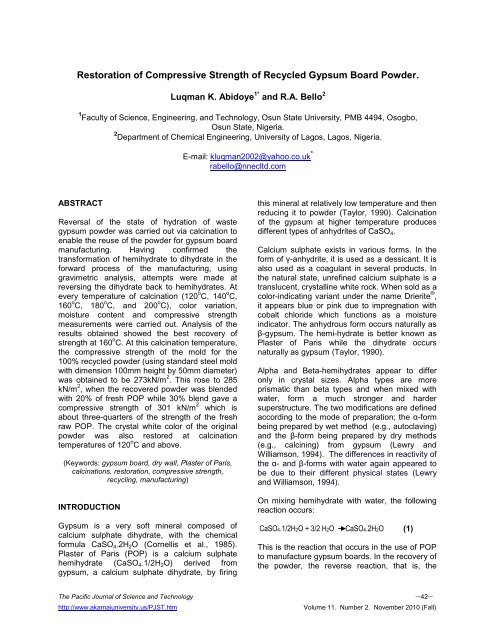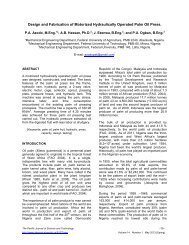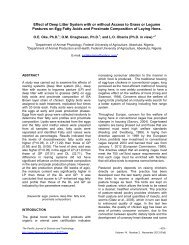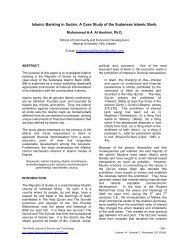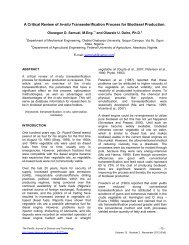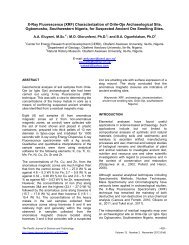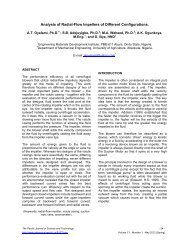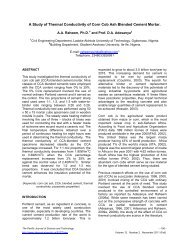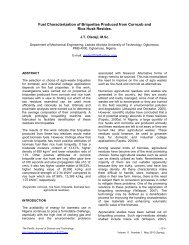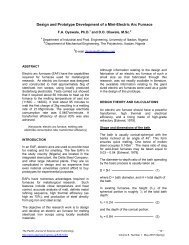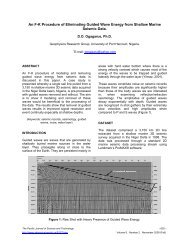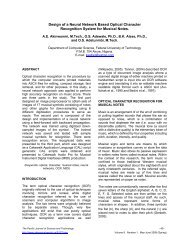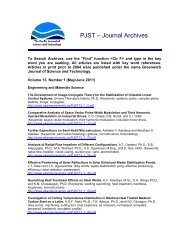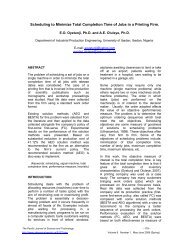Restoration of Compressive Strength of Recycled Gypsum Board ...
Restoration of Compressive Strength of Recycled Gypsum Board ...
Restoration of Compressive Strength of Recycled Gypsum Board ...
Create successful ePaper yourself
Turn your PDF publications into a flip-book with our unique Google optimized e-Paper software.
<strong>Restoration</strong> <strong>of</strong> <strong>Compressive</strong> <strong>Strength</strong> <strong>of</strong> <strong>Recycled</strong> <strong>Gypsum</strong> <strong>Board</strong> Powder.<br />
Luqman K. Abidoye 1* and R.A. Bello 2<br />
1 Faculty <strong>of</strong> Science, Engineering, and Technology, Osun State University, PMB 4494, Osogbo,<br />
Osun State, Nigeria.<br />
2 Department <strong>of</strong> Chemical Engineering, University <strong>of</strong> Lagos, Lagos, Nigeria.<br />
ABSTRACT<br />
Reversal <strong>of</strong> the state <strong>of</strong> hydration <strong>of</strong> waste<br />
gypsum powder was carried out via calcination to<br />
enable the reuse <strong>of</strong> the powder for gypsum board<br />
manufacturing. Having confirmed the<br />
transformation <strong>of</strong> hemihydrate to dihydrate in the<br />
forward process <strong>of</strong> the manufacturing, using<br />
gravimetric analysis, attempts were made at<br />
reversing the dihydrate back to hemihydrates. At<br />
every temperature <strong>of</strong> calcination (120 o C, 140 o C,<br />
160 o C, 180 o C, and 200 o C), color variation,<br />
moisture content and compressive strength<br />
measurements were carried out. Analysis <strong>of</strong> the<br />
results obtained showed the best recovery <strong>of</strong><br />
strength at 160 o C. At this calcination temperature,<br />
the compressive strength <strong>of</strong> the mold for the<br />
100% recycled powder (using standard steel mold<br />
with dimension 100mm height by 50mm diameter)<br />
was obtained to be 273kN/m 2 . This rose to 285<br />
kN/m 2 , when the recovered powder was blended<br />
with 20% <strong>of</strong> fresh POP while 30% blend gave a<br />
compressive strength <strong>of</strong> 301 kN/m 2 which is<br />
about three-quarters <strong>of</strong> the strength <strong>of</strong> the fresh<br />
raw POP. The crystal white color <strong>of</strong> the original<br />
powder was also restored at calcination<br />
temperatures <strong>of</strong> 120 o C and above.<br />
(Keywords: gypsum board, dry wall, Plaster <strong>of</strong> Paris,<br />
calcinations, restoration, compressive strength,<br />
recycling, manufacturing)<br />
INTRODUCTION<br />
<strong>Gypsum</strong> is a very s<strong>of</strong>t mineral composed <strong>of</strong><br />
calcium sulphate dihydrate, with the chemical<br />
formula CaSO4.2H2O (Cornellis et al., 1985).<br />
Plaster <strong>of</strong> Paris (POP) is a calcium sulphate<br />
hemihydrate (CaSO4.1/2H2O) derived from<br />
gypsum, a calcium sulphate dihydrate, by firing<br />
E-mail: kluqman2002@yahoo.co.uk *<br />
rabello@nnecltd.com<br />
this mineral at relatively low temperature and then<br />
reducing it to powder (Taylor, 1990). Calcination<br />
<strong>of</strong> the gypsum at higher temperature produces<br />
different types <strong>of</strong> anhydrites <strong>of</strong> CaSO4.<br />
Calcium sulphate exists in various forms. In the<br />
form <strong>of</strong> γ-anhydrite, it is used as a dessicant. It is<br />
also used as a coagulant in several products. In<br />
the natural state, unrefined calcium sulphate is a<br />
translucent, crystalline white rock. When sold as a<br />
color-indicating variant under the name Drierite ® ,<br />
it appears blue or pink due to impregnation with<br />
cobalt chloride which functions as a moisture<br />
indicator. The anhydrous form occurs naturally as<br />
β-gypsum. The hemi-hydrate is better known as<br />
Plaster <strong>of</strong> Paris while the dihydrate occurs<br />
naturally as gypsum (Taylor, 1990).<br />
Alpha and Beta-hemihydrates appear to differ<br />
only in crystal sizes. Alpha types are more<br />
prismatic than beta types and when mixed with<br />
water, form a much stronger and harder<br />
superstructure. The two modifications are defined<br />
according to the mode <strong>of</strong> preparation; the α-form<br />
being prepared by wet method (e.g., autoclaving)<br />
and the β-form being prepared by dry methods<br />
(e.g., calcining) from gypsum (Lewry and<br />
Williamson, 1994). The differences in reactivity <strong>of</strong><br />
the α- and β-forms with water again appeared to<br />
be due to their different physical states (Lewry<br />
and Williamson, 1994).<br />
On mixing hemihydrate with water, the following<br />
reaction occurs:<br />
CaSO4.1/2H2O + 3/2 H2O CaSO4.2H2O (1)<br />
This is the reaction that occurs in the use <strong>of</strong> POP<br />
to manufacture gypsum boards. In the recovery <strong>of</strong><br />
the powder, the reverse reaction, that is, the<br />
The Pacific Journal <strong>of</strong> Science and Technology –42–<br />
http://www.akamaiuniversity.us/PJST.htm Volume 11. Number 2. November 2010 (Fall)
eduction <strong>of</strong> water <strong>of</strong> hydration is what is<br />
explored.<br />
A considerable amount <strong>of</strong> waste POP or gypsum<br />
board is produced in the pottery, sanitary ware,<br />
and construction industries. Conventionally, this<br />
waste product has usually been disposed <strong>of</strong> in<br />
landfill sites and the like. This is becoming<br />
uneconomical due to the increasing cost <strong>of</strong><br />
gypsum and particularly, with diminishing<br />
productivity <strong>of</strong> some sources <strong>of</strong> gypsum, and also<br />
the introduction <strong>of</strong> landfill taxes and the likes.<br />
There is also the environmental pollution problem,<br />
as construction material wastes cannot be easily<br />
compacted and they do not readily decompose<br />
(Abdelfatah and Tabsh, 2008).<br />
Waste gypsum building materials are generated<br />
in any <strong>of</strong> three different ways: during the gypsum<br />
board manufacturing process, from new<br />
construction and from remodeling/demolition.<br />
Waste gypsum boards coming from demolition<br />
and gypsum board factories represent a serious<br />
threat to the environment as they accumulate by<br />
thousands to hundreds <strong>of</strong> thousands <strong>of</strong> tons in<br />
many dumping sites. They retain humidity and<br />
thus promote the formation <strong>of</strong> undesirable<br />
mildew.<br />
Degradation <strong>of</strong> the calcium sulphate contained in<br />
the waste gypsum boards under influence <strong>of</strong><br />
infra-red and ultraviolet radiations causes the<br />
generation <strong>of</strong> H2S and SO2 which contaminate the<br />
environment. <strong>Gypsum</strong> board contains calcium<br />
sulphate dihydrate, silicon dioxide, cellulosic<br />
fibers as well as various metal oxides such as<br />
aluminum oxide, calcium oxide, ferric oxide, and<br />
magnesium oxide. Calcium sulphate dihydrate<br />
might thus constitute a big pollution threat to the<br />
environment if it continues to mount in current<br />
quantities.<br />
All over the world, governments <strong>of</strong> each nation<br />
have put in place stringent laws that would<br />
compel the industrialists to devise methods for<br />
recycling <strong>of</strong> the waste generated from their<br />
factories. In Japan, disposal <strong>of</strong> waste gypsum<br />
board discharged from building demolitions has<br />
become a serious problem due to a large amount<br />
<strong>of</strong> waste gypsum boards (1.38 x 10 6 tons in<br />
2005) discarded as well as due to shortage <strong>of</strong><br />
landfill sites (Mihara et al., 2008). Recently, an<br />
increase in the recycling <strong>of</strong> waste gypsum boards,<br />
has been observed; however, the amount <strong>of</strong><br />
gypsum boards recycled still remains relatively<br />
low (Mihara et al., 2008). To achieve a<br />
sustainable and environment-friendly disposal, it<br />
is necessary to develop new waste gypsum<br />
recycling processes (Mihara et al., 2008).<br />
Generally, two approaches are considered for the<br />
reutilization <strong>of</strong> waste gypsum boards: material<br />
recycling and chemical recycling (Mihara et al.,<br />
2008). Regarding the material recycling, waste<br />
gypsum boards are at first subjected to a crushing<br />
and board paper separation process and then<br />
recycled as plaster board material, cement<br />
material, or soil improvement agent. In chemical<br />
recycling, reductive decomposition <strong>of</strong> CaSO4 with<br />
a reducing agent is carried out. So far, the<br />
investigation on reductive decomposition <strong>of</strong><br />
CaSO4 with H2, CO, and C has been mainly<br />
undertaken to generate SO2 for the production <strong>of</strong><br />
Sulfuric acid as well as to recycle lime (CaO) from<br />
waste gypsum (Hull et al., 1957).<br />
In their work, Mihara et al. (2008), following the<br />
chemical recycling process, proposed the<br />
utilization <strong>of</strong> gypsum boards for production <strong>of</strong><br />
CaS, which could be subsequently applied in the<br />
sulfuration treatment <strong>of</strong> metal-containing<br />
wastewater. They investigated the reductive<br />
decomposition behavior <strong>of</strong> CaSO4 to achieve a<br />
selective generation <strong>of</strong> CaS from waste gypsum<br />
boards. Then the CaS generated from CaSO4<br />
was used as a sulfuration agent in the treatment<br />
<strong>of</strong> a simulated nickel-containing wastewater.<br />
In this work, the regeneration <strong>of</strong> the plaster<br />
powder from the waste gypsum board generated<br />
during manufacturing processes and from<br />
construction sites, is explored. This is aimed at<br />
recycling the powder from the waste boards for<br />
use in manufacturing new boards. Hence, the<br />
binding properties and the compressive strength<br />
<strong>of</strong> the regenerated powder are key.<br />
The following terms are applied to various<br />
categories <strong>of</strong> materials used:<br />
Stale Raw refers to the virgin POP that had<br />
stayed over six months.<br />
Fresh Raw refers to the virgin POP newlysupplied<br />
by the manufacturers.<br />
Blend refers to the mixture <strong>of</strong> wholly recycled<br />
powder with virgin POP powder at various<br />
proportions.<br />
The Pacific Journal <strong>of</strong> Science and Technology –43–<br />
http://www.akamaiuniversity.us/PJST.htm Volume 11. Number 2. November 2010 (Fall)
EXPERIMENTAL METHODS<br />
Waste gypsum board pieces, as well as raw<br />
gypsum powder, were obtained from the gyspum<br />
board manufacturing company (NGR Investment<br />
Limited, Ogun State, Nigeria). The waste pieces<br />
were fed into laboratory crusher followed by<br />
milling. The metallic impurities were removed<br />
using magnetic separator while the fibers were<br />
removed using a fine sieve. Desired particle size<br />
was obtained using 80-mesh sieve size.<br />
Mole <strong>of</strong> Water <strong>of</strong> Crystallization<br />
The water <strong>of</strong> crystallization present was<br />
determined using gravimetric analysis. 10g <strong>of</strong> the<br />
sample powder was placed in the petri-dish and<br />
oven-dried for six hours at 180 o C. This enables<br />
the determination <strong>of</strong> mass <strong>of</strong> anhydrous calcium<br />
with which were determined the moles <strong>of</strong> water<br />
given <strong>of</strong>f and that <strong>of</strong> the bone-dried calcium<br />
sulphate. The water <strong>of</strong> crystallization was<br />
determined as the quotient <strong>of</strong> the moles <strong>of</strong> water<br />
lost over moles <strong>of</strong> anhydrous CaSO4.<br />
Detail calculation and result are presented in<br />
Appendix A.<br />
Calcination<br />
The powder (100% recycled) was calcined at<br />
100 0 C for 20 mins using an oven calciner. After<br />
calcination, the sample was taken out <strong>of</strong> the<br />
calciner, mixed with water in the ratio 1g sample<br />
to 1ml distilled water in a plastic jug with circular<br />
cross section without ridges. The round section is<br />
necessary to ensure smooth mixing <strong>of</strong> the blends<br />
in the mixer. The mixture was then poured into<br />
electric stirrer and stirred at 180rpm for 30<br />
seconds ensuring the stirrer tip is positioned at<br />
the center <strong>of</strong> the jug and at least placed not<br />
higher than the middle <strong>of</strong> the depth <strong>of</strong> the sample<br />
to avoid local setting.<br />
This mixture was molded using the standard<br />
100mm height by 50mm diameter metal mold<br />
while noting the setting time <strong>of</strong> the spill sample<br />
using a stopwatch. The experiment was further<br />
conducted for the recycle powder at 100 0 C for the<br />
calcination times <strong>of</strong> 40mins and 60mins. After<br />
each calcination period, above procedure <strong>of</strong><br />
mixing, stirring and molding were repeated while<br />
noting the setting characteristics.<br />
Higher calcination temperatures were explored.<br />
The experiment was conducted at 120 0 C, 140 0 C,<br />
160 0 C, 180 0 C, and 200 0 C for 100% recycle<br />
sample using the procedure as above. The<br />
samples were removed from the mold after<br />
proper setting is ensured and then air-dried.<br />
<strong>Compressive</strong> strength analyses were conducted<br />
on the samples using the California Bearing Ratio<br />
(CBR) machine. The procedure is as described<br />
below.<br />
The calcination conditions giving highest<br />
compressive strength was noted for the<br />
production <strong>of</strong> blends. At this condition, calcined<br />
sample was mixed with raw POP and water,<br />
stirred and molded. Various proportions <strong>of</strong> raw<br />
used with calcined 100% recycled were: 10%<br />
raw, 20% raw, and 30% raw. These samples<br />
were also subjected to compressive analyses.<br />
Determination <strong>of</strong> <strong>Compressive</strong> <strong>Strength</strong><br />
Original Area <strong>of</strong> the standard mold,<br />
The Pacific Journal <strong>of</strong> Science and Technology –44–<br />
http://www.akamaiuniversity.us/PJST.htm Volume 11. Number 2. November 2010 (Fall)<br />
A o<br />
d<br />
4<br />
2<br />
(2)<br />
where d is the mold diameter.<br />
Corrected Area,<br />
∑ = unit strain<br />
<strong>Compressive</strong> <strong>Strength</strong>=<br />
1<br />
Ao<br />
<br />
1<br />
<br />
A (3)<br />
TotalLoad<br />
CorrectedArea<br />
(4)<br />
Detailed calculations and results are presented in<br />
Appendix B.<br />
RESULTS AND DISCUSSION<br />
Water <strong>of</strong> Crystallization<br />
The moles <strong>of</strong> water <strong>of</strong> crystallization were found<br />
to be two from the gravimetric analysis. This<br />
confirms the waste powder to be the dihydrate,<br />
CaSO4.2H2O resulting from the mixture <strong>of</strong> the<br />
original POP, CaSO4.0.5H2O with water.
Thus, the assumption held that the original<br />
hemihydrate (CaSO4.0.5H2O) had been<br />
transformed to dihydrate was justified.<br />
Color <strong>of</strong> Mold<br />
The raw Plaster <strong>of</strong> Paris has crystal white color<br />
(Ababio, 2005). The recycled powder regained<br />
whitish color with rise in calcination temperature<br />
as seen in Table 1. The calcination at 100 o C gave<br />
brownish-white coloration to the powder when<br />
mixed with water. The appearance improved with<br />
increase in temperature to 120 o C which gave<br />
less-brownish white to the powder-water mixture.<br />
At 140 o C, the recycled powder regained the<br />
quality white color <strong>of</strong> the original substance giving<br />
white coloration to water-powder mixture. This<br />
was sustained at 160 o C, 180 o C, and 200 o C.<br />
Table 1: Observed Colors <strong>of</strong> the <strong>Recycled</strong> POP<br />
at Different Calcination Temperatures.<br />
Temperature ( o C) Observed Color<br />
100 Brownish white<br />
120 Less brownish (white)<br />
140 White<br />
160 White<br />
180 White<br />
200 White<br />
The recovery <strong>of</strong> the whiteness <strong>of</strong> the recycled<br />
powder as the temperature rises is a good<br />
indication <strong>of</strong> process reversal from dihydrate form<br />
to the hemi-hydrate form.<br />
<strong>Compressive</strong> <strong>Strength</strong> Variation with<br />
Temperature (100% <strong>Recycled</strong>)<br />
The compressive strength variation with<br />
temperature for wholly recycled powder shows<br />
the trend depicted in Figure 1. The compressive<br />
strength showed considerable improvement in<br />
values as temperature rose above 100 o C. The<br />
recycled powder treated at 100 o C showed no<br />
tendency to set/harden (Table 2), even at infinite<br />
time <strong>of</strong> operation.<br />
At 120 o C, the setting/hardening property was not<br />
regained at twenty minutes <strong>of</strong> calcination, but<br />
weak property <strong>of</strong> hardening was noticed at 40<br />
minutes <strong>of</strong> exposure to heat. This was further<br />
enhanced at the 60mins <strong>of</strong> calcination. But for<br />
most <strong>of</strong> the temperature ranges considered, 40<br />
minutes <strong>of</strong> calcination was most promising. The<br />
mold at higher calcination temperatures showed<br />
stronger compressive strengths.<br />
Figure 1 reveals the result <strong>of</strong> the compressive<br />
strengths for the products obtained at calcination<br />
temperatures <strong>of</strong> 120 o C, 140 o C, 160 o C, 180 o C,<br />
and 200 o C, after 40 minutes <strong>of</strong> calcination. The<br />
weakest <strong>of</strong> these was at the 120 o C region which<br />
has the value <strong>of</strong> 50.72 kN/m 2 . This rose to 140<br />
kN/m 2 at 140 o C and peaked at 160 o C with a value<br />
<strong>of</strong> 273 kN/m 2 . A slight decline to 238 kN/m 2 was<br />
observed at 180 o C. The 100% recycled powder,<br />
at 160 o C, showed a considerable recovery <strong>of</strong><br />
strength when compared to stale and fresh raw<br />
sample molds which gave compressive strengths<br />
<strong>of</strong> 308 KN/m 2 and 409 KN/m 2 , respectively (Figure<br />
2).<br />
Figure 1: <strong>Compressive</strong> <strong>Strength</strong>s <strong>of</strong> Recovered<br />
Powder at Various Calcination Temperatures<br />
(100% Recycle).<br />
Table 2: Setting Time variation with Calcination<br />
Temperature<br />
Temperature<br />
( o C)<br />
Setting Time (Mins)<br />
(100% Recycle)<br />
Calcination<br />
Time (Mins)<br />
100 ∞ 40<br />
120 1 40<br />
140 2 40<br />
160 6 40<br />
180 8 40<br />
200 11 40<br />
The Pacific Journal <strong>of</strong> Science and Technology –45–<br />
http://www.akamaiuniversity.us/PJST.htm Volume 11. Number 2. November 2010 (Fall)
<strong>Compressive</strong> <strong>Strength</strong> Variation with Moisture<br />
Content (100% recycle @ 160 o C)<br />
Having identified 160 o C, from the foregoing<br />
results, as the most promising temperature for<br />
calcination <strong>of</strong> the waste plasterboard for strength<br />
recovery, investigation <strong>of</strong> Moisture content effect<br />
was carried out. The results revealed increasing<br />
strength <strong>of</strong> the sample molds as the moisture<br />
content reduces. At 95% moisture content <strong>of</strong> the<br />
sample, calcined at 160 o C for 40 minutes, the<br />
compressive strength was 245 KN/m 2. This similar<br />
sample calcined at the same temperature but left<br />
drying for few days grows in compressive<br />
strength to 252 kN/m 2 at 52% moisture content.<br />
The trend continues with the strength <strong>of</strong> 273<br />
kN/m 2 at 20% moisture content while it peaks at<br />
296 at 11% moisture content. (Figure 3).<br />
Figure 2: <strong>Compressive</strong> <strong>Strength</strong>s <strong>of</strong> Fresh and<br />
Stale Raw.<br />
<strong>Compressive</strong> <strong>Strength</strong> Variation with Blend<br />
Proportions (Fresh Raw & Recycle at 160 o C)<br />
The possibility <strong>of</strong> obtaining a product with<br />
equivalent compressive strength as the raw POP<br />
was explored through blending the recycled<br />
powder with the fresh raw POP at proportions <strong>of</strong><br />
10%, 20%, and 30% and at a calcination<br />
temperature <strong>of</strong> 160 o C (Figure 4).<br />
The results indicate better strength. For the mold<br />
<strong>of</strong> completely-recycled powder (100% recycled),<br />
the strength started from a comparatively higher<br />
value <strong>of</strong> 273 kN/m 2 . This is followed by a slight<br />
decline at 10% blend to 266 KN/M 2 . However, the<br />
20% blend gave the remarkable boost to the<br />
strength which was 285 kN/m 2 while the 30%<br />
gave 301 kN/m 2 which was almost three-quarters<br />
<strong>of</strong> the strength <strong>of</strong> the 100% fresh raw POP (421<br />
kN/m 2 ).<br />
Figure 3: Variation <strong>of</strong> <strong>Compressive</strong> <strong>Strength</strong> with<br />
Moisture Content (100% Recycle @ 160 o C).<br />
Fashina (2008) explored the direct use <strong>of</strong> the<br />
recovered waste powder without pre-treatment<br />
via calcination. He blended the recycled powder<br />
directly with raw POP. The 20% blend at this<br />
calcination point (160 o C) gave strength (285<br />
kN/m 2 ) more than twice the strength <strong>of</strong> 70% raw<br />
blend (112 kN/m 2 ) in Fashina’s work. The effect<br />
further multiplied almost three-fold with 30% raw<br />
blend which gave 301 kN/m 2 at this calcination<br />
temperature. Figure 4 is the graphical<br />
representation <strong>of</strong> this scenario.<br />
CONCLUSION<br />
Calcination <strong>of</strong> recovered waste POP has been<br />
found to be a satisfactory condition <strong>of</strong> treatment<br />
for the recovery <strong>of</strong> the compressive strength <strong>of</strong><br />
the material. Calcination <strong>of</strong> the recovered POP<br />
returns the lost strength to the powder thereby<br />
enhancing its reusability. Of all the calcination<br />
temperatures investigated, 160 o C was optimal.<br />
Hence, the re-enhancement <strong>of</strong> waste<br />
plasterboard can be easily achieved with<br />
calcination <strong>of</strong> the waste at this temperature.<br />
The mixture <strong>of</strong> the raw POP powder with water<br />
transformed the hemihydrate to a dihydrate which<br />
must be reversed in the resulting waste in order<br />
to restore the desired property <strong>of</strong> strength.<br />
The Pacific Journal <strong>of</strong> Science and Technology –46–<br />
http://www.akamaiuniversity.us/PJST.htm Volume 11. Number 2. November 2010 (Fall)
Figure 4: <strong>Compressive</strong> <strong>Strength</strong> against Blends<br />
(Fresh Raw).<br />
The compressive strength increases with<br />
moisture content. So, drying the recycled<br />
products under sun for good length <strong>of</strong> time gives<br />
an improved strength to the molds.<br />
Color degradation is another sign <strong>of</strong> degenerated<br />
POP powder as the original and fresh sample<br />
retains white appearance.The whitish colour <strong>of</strong><br />
the original gypsum powder can be easily<br />
restored in the waste with calcination above<br />
120 0 C.<br />
The raw Plaster <strong>of</strong> Paris is hygroscopic. It is, thus,<br />
necessary to calcine a stale raw Plaster <strong>of</strong> Paris<br />
powder to release the water trapped in its crystal<br />
lattices before its eventual use.<br />
APPENDIX A - Determination <strong>of</strong> Mole <strong>of</strong> Water<br />
<strong>of</strong> Crystallization<br />
Mass <strong>of</strong> Dish, Md = 37.15g<br />
Mass <strong>of</strong> Dish + <strong>Recycled</strong> powder, Mdp = 47.15g<br />
After heating for six hours at 180 0 C<br />
Mass <strong>of</strong> Dish + Dried Powder, Mdd = 45.36g<br />
Mass <strong>of</strong> water lost, Mw = 47.15 – 45.36<br />
= 1.79g<br />
Molar mass <strong>of</strong> water = 18 g/mol<br />
Mole <strong>of</strong> water lost, Mow = 1.79/18<br />
= 0.099mol<br />
Mass <strong>of</strong> anhydrous CaSO4 = Mdd – Md<br />
= 45.36 – 37.15<br />
= 8.21g<br />
Molar mass <strong>of</strong> CaSO4 = 159.6 g/mol<br />
Mole <strong>of</strong> anhydrous CaSO4 = 8.21/159.6<br />
= 0.051 mol<br />
To determine x in CaSO4 .xH2O (i.e., ratio <strong>of</strong> mole<br />
<strong>of</strong> water to CaSO4):<br />
x = 0.099/0.051<br />
= 1.94<br />
≈ 2<br />
Therefore, the molecular formula <strong>of</strong> the<br />
compound is:<br />
CaSO4. 2H2O<br />
(i.e., the mole <strong>of</strong> the water <strong>of</strong> crystallization is 2).<br />
APPENDIX B - <strong>Compressive</strong> <strong>Strength</strong><br />
Determination and Strain-Stress Analysis<br />
Parameters Used<br />
Area, Ao = Л d 2<br />
The Pacific Journal <strong>of</strong> Science and Technology –47–<br />
http://www.akamaiuniversity.us/PJST.htm Volume 11. Number 2. November 2010 (Fall)<br />
4<br />
Volume = Area x height<br />
Bulk Density, γb = weight<br />
Volume<br />
Water content = Ww x 100%<br />
Ws<br />
Ww = water weight (lost in drying)<br />
Ws = dry solid weight<br />
Corrected Area, A1 = Ao<br />
1- ∑<br />
∑ = unit strain<br />
Stress( <strong>Compressive</strong> <strong>Strength</strong>) = Total<br />
Load/Corrected Area
Standard Mold Physical Properties<br />
Diameter= 50mm, Height = 100mm<br />
Area, Ao = 1.963 x 10- 3<br />
Volume = 1.963 x 10 -4 m 3<br />
Unit Strain(∑)<br />
(ΔL/Lo)x10 -2<br />
Fresh Raw P.O.P (100%)<br />
Weight = 300.64g<br />
Table B1: <strong>Compressive</strong> Test Results on Fresh Raw P.O.P Mold<br />
Unit Strain(∑)<br />
(ΔL/Lo) x10-2 Corrected Area, A1,<br />
X 10-3 (m2 Total Load on Sample Mold Mold Stress<br />
)<br />
(KN)<br />
(KN/M2 )<br />
0 - 0 0<br />
0.2 1.967 62 31.52<br />
0.4 1.971 148 75.09<br />
0.6 1.975 240 121.52<br />
0.8 1.979 339 171.3<br />
1.0 1.983 430 216.84<br />
1.2 1.987 512 257.67<br />
1.4 1.991 620 311.40<br />
1.6 1.995 700 350.88<br />
1.8 1.999 770 385.19<br />
2.0 2.003 820 409.39<br />
2.2 2.007 760 378.67<br />
2.4 2.011 720 358.03<br />
Table B2: <strong>Compressive</strong> Tests Results on 100% <strong>Recycled</strong> P.O.P Mold.<br />
Corrected<br />
Area, A1,<br />
X 10-3 (m 2 )<br />
Mold Stress<br />
@ 120 o C<br />
Mold Stress<br />
@ 140 o C<br />
Mold Stress<br />
@ 160 o C<br />
Mold Stress<br />
@ 180 o C<br />
Mold Stress<br />
@ 200 o C<br />
0 - 0 0 0 0 0<br />
0.2 1.967 1.02 3.56 19.32 45.75 2.03<br />
0.4 1.971 1.52 6.09 51.04 91.32 16.24<br />
0.6 1.975 2.03 8.10 81.01 121.52 52.66<br />
0.8 1.979 7.07 17.18 116.22 156.64 98.03<br />
1.0 1.983 12.61 28.24 151.29 189.11 139.18<br />
1.2 1.987 18.12 44.29 176.14 216.41 175.14<br />
1.4 1.991 23.10 63.28 195.88 226.02 213.96<br />
1.6 1.995 28.07 83.21 205.51 238.09 238.60<br />
1.8 1.999 34.52 105.05 195.09 230.12 248.12<br />
2.0 2.003 42.44 125.81 192.71 219.67 241.64<br />
2.2 2.007 46.84 139.51 224.22<br />
2.4 2.011 50.72 115.37 248.63<br />
2.6 2.015 50.12 272.95<br />
2.8 2.0195 50.01 260.96<br />
3.0 2.024 48.91 243.08<br />
3.2 2.028<br />
3.4 2.032<br />
3.6 2.036<br />
The Pacific Journal <strong>of</strong> Science and Technology –48–<br />
http://www.akamaiuniversity.us/PJST.htm Volume 11. Number 2. November 2010 (Fall)
Table B3: <strong>Compressive</strong> Tests Results on P.O.P Molds <strong>of</strong> Blends (Fresh Raw) (Calcination @160 o C).<br />
Unit Strain(∑)<br />
(ΔL/Lo) x10-2 Corrected Area, A1,<br />
X 10-3 (m2 Mold Stress<br />
Mold Stress<br />
Mold Stress<br />
)<br />
@ 10% Raw Blend @ 20% Raw Blend @ 30% Raw Blend<br />
0 - 0 0 0<br />
0.2 1.967 28.47 49.82 43.72<br />
0.4 1.971 65.45 90.82 86.25<br />
0.6 1.975 106.33 139.24 131.65<br />
0.8 1.979 146.54 181.91 166.75<br />
1.0 1.983 176.5 216.84 206.76<br />
1.2 1.987 211.37 246.60 241.57<br />
1.4 1.991 215.97 261.18 261.17<br />
1.6 1.995 225.51 269.15 279.33<br />
1.8 1.999 239.24 275.23 290.63<br />
2.0 2.003 250.33 285.11 298.27<br />
2.2 2.007 258.14 262.54 301.16<br />
2.4 2.011 266.05 233.26 293.10<br />
2.6 2.015 240.28 222.19 283.22<br />
2.8 2.0195 211.22 266.63<br />
3.0 2.024<br />
3.2 2.028<br />
3.4 2.032<br />
3.6 2.036<br />
ACKNOWLEDGEMENTS<br />
NGR Investment Limited, Ogun state, Nigeria is<br />
acknowledged for the supply <strong>of</strong> both the raw<br />
Plaster <strong>of</strong> Paris and the waste gypsum boards.<br />
The authors also acknowledge the management<br />
<strong>of</strong> Soil Laboratory, Civil Engineering Department,<br />
University <strong>of</strong> Lagos for carrying out the<br />
compressive strength tests and others free <strong>of</strong><br />
charge. Also, the management <strong>of</strong> Petroleum<br />
Laboratory <strong>of</strong> the Department <strong>of</strong> Chemical<br />
Engineering for availing us their equipment and<br />
space for the successful execution <strong>of</strong> this<br />
research.<br />
REFERENCES<br />
1. Ababio, O.Y. 2005. New School Chemistry. 3rd<br />
ed. Africana First Publishers Ltd., Onitsha, Nigeria.<br />
2. Abdelfatah, A., and Tabsh, S.W. 2008. “Recycling<br />
Concrete: A Possible Approach to Improve the<br />
Environment”. Rec Show ’08 Middle East<br />
Recycling, Waste & Environmental Management<br />
Exhibition & Congress: Dead Sea, Jordan.<br />
3. Cornelis, K., Cornelius, S. and Hurlbut, J. 1985.<br />
Manual <strong>of</strong> Mineralogy, 20th ed. John Wiley and<br />
Sons: New York, NY. 352-353.<br />
4. Fashina, R. 2008. “Recycling <strong>of</strong> POP Using Dry<br />
Method”. Unpublished B.Sc. Thesis, Department <strong>of</strong><br />
Chemical Engineering, University <strong>of</strong> Lagos: Lagos<br />
Nigeria.<br />
5. Hull, W.Q., Schon, F., and Zirngibi H. 1957.<br />
“Sulfuric Acid from Anhydrite”. Ind. Eng. Chem.<br />
49(8):1204-1214.<br />
6. Lewry, A.J. and J. Williamson. 1994. “The Setting<br />
<strong>of</strong> <strong>Gypsum</strong> Plaster”. Journal <strong>of</strong> Material Science.<br />
29:5279-5284.<br />
7. Mihara, N., Soya, K., Kuchar, D., Fukuta, T., and<br />
Matsuda, H. 2008. “Utilization <strong>of</strong> Calcium Sulfide<br />
Derived from Waste <strong>Gypsum</strong> <strong>Board</strong> for Metal-<br />
Containing Wastewater Treatment”. Global Nest<br />
Journal. 10(1):101-107.<br />
8. Penny, N. 1993. The Materials <strong>of</strong> Sculpture. Yale<br />
University Press: New Haven, CT.<br />
9. Taylor, H.F.W. 1990. Cement Chemistry.<br />
Academic Press: New York, NY. ISBN 0-12-<br />
683900-X. 186-187.<br />
The Pacific Journal <strong>of</strong> Science and Technology –49–<br />
http://www.akamaiuniversity.us/PJST.htm Volume 11. Number 2. November 2010 (Fall)
ABOUT THE AUTHORS<br />
Luqman K. Abidoye, M.Sc. is a Lecturer in the<br />
College <strong>of</strong> Science, Engineering and Technology<br />
(S.E.T.), Osun State University, Osogbo, Nigeria.<br />
He earned his B.Sc. (Hons) degree in Chemical<br />
Engineering in 2003 from Ladoke Akintola<br />
University <strong>of</strong> Technology (LAUTECH),<br />
Ogbomoso, Oyo State, and his M.Sc. in Chemical<br />
Engineering, University <strong>of</strong> Lagos, Nigeria in 2010.<br />
He is a Doctoral Staff Training Fellow <strong>of</strong> the Osun<br />
State University. His research interest is in the<br />
area <strong>of</strong> waste utilization and he currently delves<br />
into the bi<strong>of</strong>uel generation from waste biomass.<br />
Pr<strong>of</strong>essor R.A. Bello, is a renowned Lecturer in<br />
the Department <strong>of</strong> Chemical Engineering,<br />
University <strong>of</strong> Lagos, Nigeria. He has<br />
specialization in the area <strong>of</strong> Biochemical<br />
Engineering and had authored several<br />
international papers in the field.<br />
SUGGESTED CITATION<br />
Abidoye, L.K. and R.A. Bello. 2010. “<strong>Restoration</strong><br />
<strong>of</strong> <strong>Compressive</strong> <strong>Strength</strong> <strong>of</strong> <strong>Recycled</strong> <strong>Gypsum</strong><br />
<strong>Board</strong> Powder”. Pacific Journal <strong>of</strong> Science and<br />
Technology. 11(2):42-50.<br />
Pacific Journal <strong>of</strong> Science and Technology<br />
The Pacific Journal <strong>of</strong> Science and Technology –50–<br />
http://www.akamaiuniversity.us/PJST.htm Volume 11. Number 2. November 2010 (Fall)


